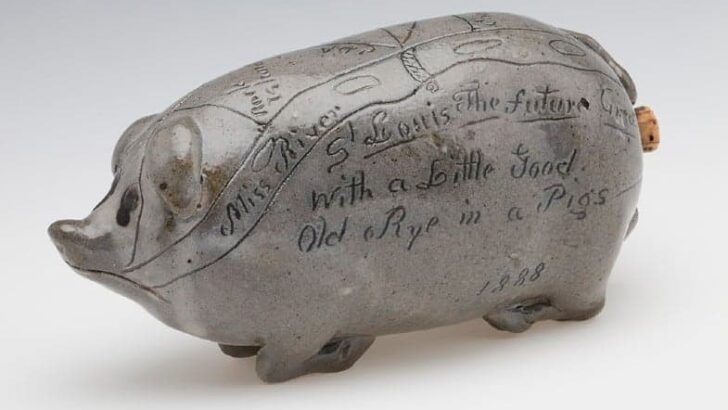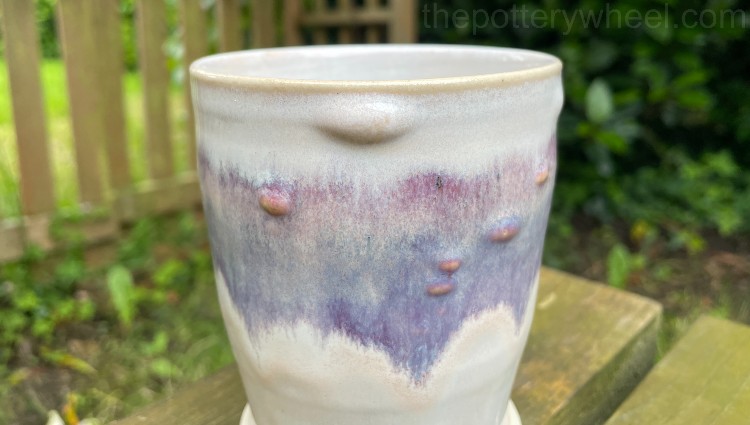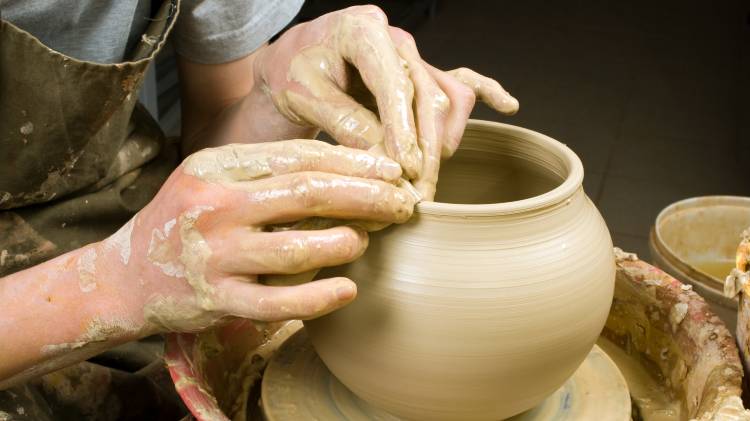You may be a pottery enthusiast or, better yet, an antique collector. At one point in your endeavors, you might have come across the term Anna pottery and wondered, “what is Anna pottery?”. Well, worry not. This article will provide a description of what Anna pottery is all about.
Anna pottery is stoneware from Anna, Illinois. Pieces of Anna pottery date between 1859 and 1896, when the pottery was in operation. The most well-known pieces of Anna pottery are pig flasks and jugs decorated with snakes. Much Anna Pottery is salt-glazed, resulting in a brown, blue, or purple finish.
Have you ever visited an antique museum and come across decorative pottery with surprisingly earthy figures of frogs, snakes, and pigs? The chances are high that the antique you spotted is a piece of Anna Pottery. These artifacts are made with pottery clay, more specifically, kaolin clay found in Anna, Illinois.

What is Anna Pottery? – a Historical Perspective
The word ‘Anna’ symbolizes a place in Union County, Illinois called Anna. In the winter of 1858, Andrew Kirkpatrick, and his two sons moved from Mound City and settled in Anna.
Later on, the two brothers, Cornwall and Wallace Kirkpatrick would be the talented artists who created Anna pottery. Thus, the name Anna Pottery is derived from the place these pieces of art were first made.
The brothers spotted a place with good kaolin clay, which they used to make stoneware. The stoneware became the raw material for what was to become a thriving business.
They made utilitarian pottery such as plates, pitchers, crocks, buckets, roof tiles, and funnels. These items brought in enough money to run the pottery house and to afford them time to tap into their creative juices.
Drawing from the happenings of the time, the brothers made pottery pieces that have, with time, become pieces of art. The most outstanding of these pieces are the snake jugs and pig flasks.
These pieces speak volumes about what life was like in Illinois in the late 19th century. We will delve into the significance of these designs shortly.
When was Anna Pottery Made?
The Anna Pottery was operated by the Kirkpatrick brothers between 1859 and 1896. For a long time, though, they remained unnoticed and unrecognized in the world of art.
This is despite the fact that they took part in international art exhibitions such as the Philadelphia Centennial in 1876 and the World’s Columbian Exposition in Chicago in 1893.
Works on American ceramics at the time barely had any records of the Kirkpatrick Anna Pottery. It was not until 1938 that the first inscription of Anna pottery was published in the New York Historical Society. Still, there is some missing information about the Anna Pottery business and products until today.
Pieces of this pottery can be found in several museums in the USA, including the Anna Kirkpatrick Pottery Museum and the Union County Museum in Southern Illinois. They can also be found in private art collections.
Anna Pottery Designs
Anna pottery has an unusual distinctive look. So, what lies beneath the unique artistry of this unusual make of pottery? The Kirkpatrick brothers’ handiwork is popular for its unusual, unique pieces of stoneware such as those with images of snakes, pigs, and frogs.
They made jugs with realistic writhing snakes on them, bottles and flasks were hog-shaped and encrypted, and drinking cups had images of frogs in them.
Most of these ideas were inspired by events that were unfolding in Illinois at the time, more so the Temperance movement and the political atmosphere.
One of the brothers, Cornwell, was a politician himself having been the mayor of Anna for three terms. For instance, the pig flasks had whimsical, satirical encryptions that mocked or appraised the politics of the time.
The temperance movement was a big issue in the region, and it thus inspired many of the designs. Kirkpatrick brothers also got some of their ideas from the cartoon section of the local dailies.
The snakes in most jugs are said to have been inspired by the biblical portrayal of the serpent. Thus, engraving snakes on whiskey jugs was a statement against alcoholism, which was raging in the Anna region in the late 19th century.
Also, it showed support for the Temperance movement. Wallace Kirkpatrick is said to have been an avid collector of pet snakes, so we may conclude that the snakes were his idea. He used the snakes for his shows and sold them to circuses as well (source).
Snake Jugs
These are arguably the most iconic pieces of Anna pottery. Some people may even refer to them as dramatic because of their whimsical, humorous, and sarcastic nature.
These bizarre snake jugs were made between 1860 and 1885. At present, there are around only eleven known large snake jugs in various collections (source).
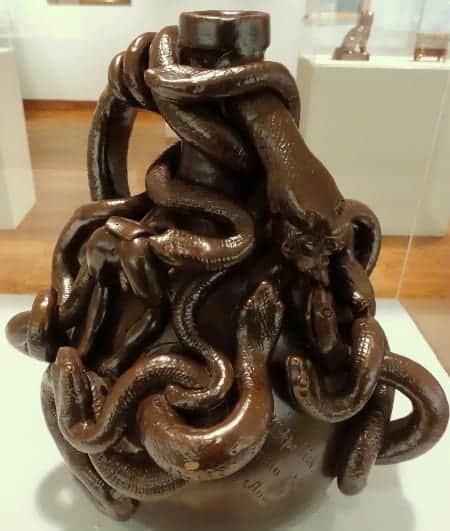
At 10-12 inches in height, the jugs have long-neck bulbous shapes and a bearded head protruding from the front shoulder. The jugs’ distinguishing feature is that they are covered with different densities of snakes and bottom halves of human bodies such that the humans seem to be diving into the jug.
The jugs explicitly bring out the temperance theme. The temperance movement addressed issues such as public drunkenness, and the configurations of snakes on the jugs suggest the drunkard’s dream or delirium tremens.
The snakes are carved as if to be coming out of the jars, figurative for portraying whiskey as the devil’s drink.
Pig Flasks
These were produced in the period between 1869 and 1893 (source). Made in their thousands, many survive today in public and private collection rooms.
Pig bottles often had road maps and railroads encrypted on their bodies. The classic pig, for instance, has a pattern of roads that were in Illinois in the last half of the 19th century. The pattern is so detailed that cities found along the roads, such as Chicago and Cincinnati, are also identified.
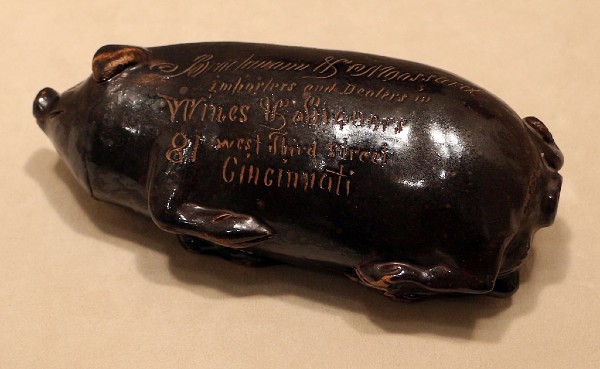
Pig flasks are metaphorical in that they represent the Midwest economy. You see, corn was an important crop in the region, but it was worth a lot more when it was used to feed and fatten pigs.
The corn was also used to make whiskey, which the pig bottle was made for holding.
The stand of the Kirkpatrick brothers against irresponsible intake of whiskey is evident from the design of the bottle. The suggestion is that if you guzzle too much alcohol, you will end up like a pig.
Most of the pig flasks available today are about 5 to 8 inches long. The most intriguing fact about the pig flasks is that they were hand-modeled by Wallace and Cornwell.
Apart from snakes and pigs, the two potters of Anna also incorporated lizards, frogs, and spiders in their pieces to pass a message or purely for decorative intentions.
Why is Anna Pottery so Valuable?
Over the last few decades, the value of Anna pottery has been on a steady rise. It is becoming one of the most desirable art pieces in the world today, especially for artifact collectors. The value of these pieces has been rising for the following reasons:
- It is rare. The Kirkpatrick brothers are the only ones who could make such unique pieces of art. The intricate hand-decorated artifacts are hard to find in any other place. As the pieces become harder to find, their value increases.
- Pieces of Anna Pottery are aesthetically pleasing. Artists and antique collectors in particular love figurative forms, something that Anna Pottery is rich in.
Some of the pieces tell stories, others have whimsical encryptions, and others are plain hilarious. The pig bottles, for instance, have a drinking opening at the rear end where pigs carry out defecating business. This will definitely catch your interest! - The snake jars will scare you at first because of how real those snakes look. The realness and the significance of the Anna Pottery artifacts are so intriguing that collectors are willing to pay top dollar for them.
- The highly decorative nature of these pieces has made them popular among folk in art circles. They stand out among other pieces of art- they will leave a lasting impression on you.
They are so captivating that even people who are not in the least interested in art will stop to stare.
Decoration on Anna Pottery
The decorative methods that the Kirkpatrick brothers applied in most of their pieces include:
Salt-Glazing
Salt glazing involves throwing common salt into a kiln at peak temperature during the firing process. Sodium in the salt reacts with silica in the clay to form sodium silicate.
This in turn forms a glossy coating on the pottery. Most pig bottles made by the Kirkpatrick brothers are salt-glazed. Salt glazing results in brown, blue, or purple ornaments.
Cobalt-Blue Decoration
The Kirkpatrick brothers also applied the cobalt-blue glaze in decorating some of their pieces. Cobalt blue is often used over a salt finish.
The result is a rich glossy blue which accentuates the pieces and reveals a depth to the finish. A number of snake jugs have cobalt-blue decorations on them.
Final Thoughts
If you are an art and antique enthusiast, Anna Pottery will definitely spark your interest. In case you are still wondering what is Anna Pottery, visit the museums mentioned in the article for a first-hand look at some amazing examples of Anna Pottery.
Attributions for images:
Featured Image: Anna Pottery Pig Flask. Sourced, Wikimedia Commons: “Anna Pottery / Public Domain“

